Review of the best and warmest insulating jackets
This article explains the various different types of insulating mid-layer jackets (like down, primaloft and Buffalo), compares the advantages and disadvantages of each, and offers some recommendations.
First written in 2012. Updated March 2020. Recently overhauled in light of the popularity of my other comparison articles such as base layers, camping mats, bivy bags, camping stoves and multi fuel stoves (see the complete list here).
*NEW* – Comparison of Bikepacking Bags
[divide]
The Best Mid Layers
The best mid layers explained, compared and reviewed.
–
[one_fourth]
Down Jackets
[/one_fourth]
[one_fourth]
Synthetic Insulated Jackets
aka “Belay jackets” e.g. Primaloft
[/one_fourth]
[one_fourth]
Pile+Pertex Smocks
e.g. Buffalo
[/one_fourth]
[one_fourth_last]
Fleece
[/one_fourth_last]
–
[divide]
What is a Mid Layer?
Mid layers are the garments whose primary purpose is insulation. They are generally worn on top of a base layer and, when conditions dictate, beneath an outer ‘shell’ layer. Unlike base and outer layers, you might wear more than one midlayer at a time if it’s cold enough.
A midlayer’s job is to trap as much of your body heat is as possible. Simple as that. The base layer can sort out any sweat and the outer shell can worry about wind and rain.
A thick woolly jumper or a cosy university hoodie are examples of insulating midlayers. What differentiates a good outdoor garment from a high street item is:
The Cut & Design
Outdoor kit tends to be closer fitting to minimise excess material, making a garment smaller and lighter. They also tend to have features like a high collar, adjustable cuffs and conveniently located pockets.
The Warmth-to-Size/Weight Ratio
A big woolly coat might keep you warmer than an expensive fleece from an outdoors shop but if it won’t fit in your rucksack then it’s not going to be much use.
What is the Best Mid Layer?
If it were just warmth-to-weight that was the issue then down jackets would easily be the best mid layers. However, there are other factors such as how robust they are, can you ventilate and manage your temperature levels, and how they hold up in wind and rain (hint: down jackets are not good at any of those things).
Below is an overview of the four most common types of mid layers (click to jump straight to them):
- Fleece
- Pile+Pertex Smocks (e.g. Buffalo)
- Insulated Synthetic Jackets (e.g. Primaloft)
- Down Jackets
The pros and cons of each are listed and compared to the other mid layers.
Did you know I have a whole series of Comparison articles?
They include: Base Layer Materials, Camping Mats and Bivy Bags. Browse them all here >>
[divide]
Best Mid Layer Comparison Chart
Detailed mid layer descriptions are below but first a table to compare the materials. Practicality includes how tough they, how breathable and how comfortable to wear on the move. Warmth:Weight Ratio.
| Type | Warmth | Warmth:Weight Ratio | Practicality | Recommended |
| Fleece | |
|
|
|
| Pile+Pertex Smocks (e.g. Buffalo) | |
|
|
Buffalo Mountain Shirt ➜ |
| Synthetic Insulated Jackets (e.g. Primaloft) | |
|
|
Rab Xenon ➜ |
| Down Jackets | |
|
|
Rab Neutrino ➜ |
1. Fleeces
–
[one_fourth]
–
[/one_fourth]
[one_fourth]
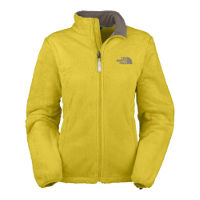
[/one_fourth]
[two_fourth_last]
Fleece Mid Layers
Warmth: Low
Warmth-Weight Ratio: Low
Practicality: Good
Cost: Low
[/two_fourth_last]
What is fleece?
Fleece is the name given to a range of materials made from synthetic fibres which are commonly used for insulating clothing. There is nothing fancy about them. A typical fleece top might not be any warmer than the jumper your gran knitted you for Christmas but the design and cut will probably be a little more suited to outdoor pursuits (unless your gran’s a real pro).
How does Fleece Insulate?
Fleece tends to be lighter than wool for the same level of insulation. It also retains much of its insulating properties when wet and, since it’s “hydrophobic” (meaning that it only holds a small amount of water) it will dry more rapidly too.
There are plenty of types of different fleece with different names and claims, some of which may be more revolutionary than others. As a broad rule of thumb, the thicker, furrier ones tend to be warmer but less wind-resistant whilst the thinner, tougher looking ones aren’t as warm but offer some wind protection.
Cost
£10-£100+. The fleece I bought for £10 over 10 years ago has been around the world on a bike with me, into the High Arctic and up to 6,000-metres. More expensive fleeces might have some benefits but I’d suggest that the returns diminish as the price increases.
Fleece Summary
Fleece is ubiquitous, cheap, robust and good across a range of conditions. It offers only a limited amount of insulation though and is too bulky to rely on solely in cold conditions.
[button color=”green” link=”http://amzn.to/2grUhk3″ target=”_blank” size=”medium” fontw=”bold” align=”center” radius=”6″]Check Prices for Fleece Midlayers Online >>[/button]
2. Pile+Pertex Smocks
(e.g. Buffalo)
–
[one_fourth]
–
[/one_fourth]
[one_fourth]
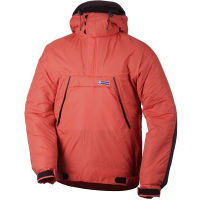
[/one_fourth]
[two_fourth_last]
Pile+Pertex Smock Mid Layers
Warmth: High
Warmth-Weight Ratio: Low
Practicality: Very Good
Cost: Medium
[/two_fourth_last]
What are Pile+Pertex Smocks?
Pile+Pertex Smocks – often called “Buffalos” after the manufacturer of the best known smock – are pull-over tops that are furry on the inside with a nylon shell on the outside.
How do Pile+Pertex Smocks Insulate?
Pile, or fibre pile, works in a similar way to animal fur. It provides insulation against the cold and knits tightly together to retain that insulation when wet. Being made of many small strands allows the pile to dry quickly too and feel less chilly against your skin as the tips dry first.
These smocks also have a shell made of Pertex or a similar nylon material that makes them tougher and offers some wind protection (for more on this, see Andy Kirkpatrick’s history of the smock).
Pros & Cons of Pile+Pertex Smocks
Buffalos are tough, no-nonsense garments. Some people love them as a one-size-fits-all approach which you can get wet, treat roughly, not given a second thought to and still stay warm at the end of it all. Others think you would be better off just having two separate layers that were smaller and lighter.
Their key advantage over synthetic and down jackets, apart from their toughness, is their ability to regulate your temperature. The pile means they wick and breathe much more effectively than down or synthetic jackets (i.e. you won’t get as sweaty) and they generally have long venting zips on both sides, deep chest zips and adjustable cuffs. This means that when it’s really cold you can use these smocks on the move in a way that you can’t with down and synthetic jackets.
The main downside is that they are much bigger and heavier than down and synthetic jackets.
Pile Smock Comparison Table
| Brand | Model | Weight | Ounces | Price | Check price | Notes |
|---|---|---|---|---|---|---|
| Buffalo | Mountain Shirt | 630g | 22oz | £110 | Check price here | The original pile smock |
| Buffalo | Special 6 | 675g | 24oz | £125 | Check price here | Longer cut Mountain Shirt |
| Buffalo | Active | 630g | 22oz | £110 | Check price here | Different, softer, non-Pertex shell |
| Snugpak | Pile Shirt Elite | 1270g | 45oz | £90 | Check price here | Includes hood |
| Montane | Extreme Smock | 1050g | 37oz | £113 | Check price here | Includes hood |
Smock Summary
Bigger and heavier than synthetic jackets but much tougher and good temperature regulation so better for using on the go.
[divide]
[box type=”info” fontsize=”14″]
Recommended Smock: Buffalo Mountain Shirt
[one_fourth]
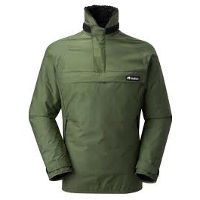 [/one_fourth]
[/one_fourth]
[two_fourth]
Buffalo are the only manufacturers still consistently making pile+pertex smocks but, thankfully, they’re also the best. I’ve used their Mountain Shirt for many years for winters walking in Scotland and cycling through Iran.
>> Used by the author– >> Rating:![]()
![]()
![]()
![]()
![]()
[/two_fourth]
[one_fourth_last]
Want One?
[button color=”blue” link=”http://amzn.to/2flIl1h” target=”_blank” size=”medium” fontw=”bold” align=”center” radius=”6″]Check Price >>[/button]
Or try Cotswold Outdoor
[/one_fourth_last]
[/box]
3. Synthetic Insulated Jackets
aka Belay Jackets e.g. Primaloft
–
[one_fourth]
–
[/one_fourth]
[one_fourth]
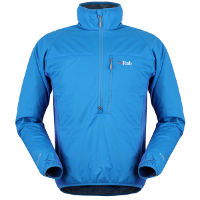
[/one_fourth]
[two_fourth_last]
Synthetic Insulated (Primaloft) Mid Layers
Warmth: High
Warmth-Weight Ratio: High
Practicality: Average
Cost: Medium
[/two_fourth_last]
What are Synthetic Insulated Jackets?
Synthetic jackets – also called “belay jackets” as they are popular with climbers who have to sit still in cold, damp conditions while belaying – are similar to down jackets except that they use a synthetic filling rather than animal feathers and down. They’re much the same as synthetic sleeping bags too.
They tend to have shells made of thin nylon or Pertex which gives them a shiny, plasticy look. They are filled with “synthetic microfibres” which mimic the lofting properties of down while staying resistant to water. The most common brand of this microfibre filling is Primaloft. As such, the tops are sometimes called by a third name: Primaloft jackets.
To recap, synthetic insulated jackets are also called Belay Jackets and Primaloft Jackets, or combination of the three e.g. “synthetic belay jackets” or “insulated Primaloft jackets”.
Pros & Cons of Synthetic Primaloft Jackets
Belay jackets offer a really good level of warmth for very low weights (from 200g or less) and without the fragility and fear of water that you get with down. They also tend to be slightly cheaper. And, as a reasonably new technology, they should only improve with time. As a warm top to put in your bag these are hard to beat.
However, if you are going somewhere dry then a down jacket will give better warmth for its weight. And if you are going somewhere cold and need to exercise in warm clothing then fleece or a pile smock will be much better as belay jackets quickly get very sweaty.
Insulated Jacket Summary
Belay jackets are second only to down for warmth-to-weight but cheaper and not susceptible to water damage. A bit sweaty to walk in though.
[button color=”green” link=”http://amzn.to/2g0V5M4″ target=”_blank” size=”medium” fontw=”bold” align=”center” radius=”6″]Check Prices for insulated jackets online >>[/button]
[divide]
[box type=”info” fontsize=”14″]
Suggested Insulated Jacket: Rab Xenon X
[one_fourth]
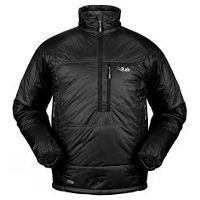
[/one_fourth]
[two_fourth]
When shopping for an insulated jacket, always compare the type of filling (e.g. Primaloft One or Primaloft Eco) and the quantity of it. There’s no point buying an ultra light jacket if it’s only got 10 grams of insulation.
The Rab Xenon X is an update on the popular Rab Generator which my wife’s had for years. It’s total weight is 342g (12oz), of which the Primaloft Gold insulation is 160g – almost 50%.
>> Excellent fill-to-weight ratio– >> Rating:![]()
![]()
![]()
![]()
![]()
[/two_fourth]
[one_fourth_last]
Want One?
[button color=”blue” link=”http://amzn.to/2gDPb3n” target=”_blank” size=”medium” fontw=”bold” align=”center” radius=”6″]Check Price >>[/button]
[/one_fourth_last]
[/box]
4. Down Jackets
–
[one_fourth]
–
[/one_fourth]
[one_fourth]
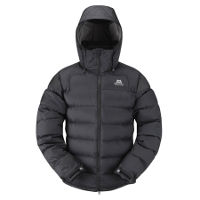
[/one_fourth]
[two_fourth_last]
Down Jacket Mid Layers
Warmth: Very High
Warmth-Weight Ratio: Very High
Practicality: Very Poor
Cost: High
[/two_fourth_last]
What are Down Jackets?
Down is a type of very fine feather which has strong insulating properties. It is particularly useful in outdoor clothing because of its excellent warmth to size and weight ratio. Down jackets are much like down duvets, down pillows and down sleeping bags.
How do Down Jackets Insulate?
The quality of a down jacket (or sleeping bag for that matter) can be assessed on three metrics:
- Down to Feathers Ratio: Fluffy white down is warmer than the actual feathers of an animal but more expensive. As such, a cheaper down jacket might only contain 80% down, with the remaining 20% being feathers, whereas a fancier one might be 95% down.
- Fill Power (“Loft”): Fill Power is a technical measurement for a down’s “loft”, that is, how much space a given weight of it fills. The more space it fills the warmer it will be. A cheaper jacket might have a fill power of 500 and a top quality one might be 800+.
- Animal Pedigree: Different birds from different parts of the world are variously heralded as having the best down. Canadian goose down is a popular choice, for example. Unless you’re a real nerd, this probably isn’t too important beyond the marketing brochure.
Pros & Cons of Down Jackets
Down provides a better insulation for a given size and weight than any other material, natural or man-made. As such, down jackets, salopettes, booties, mittens and suits are popular choices for outdoor pursuits.
The downside is that they are invariably expensive, often a bit fragile (you can get jackets with tougher shells but you start to lose the size and weight benefits then) and highly susceptible to water.
When down gets wet it clumps together and it’s insulating properties plummet. Of coruse, any top that gets wet is not going to insulate you as well but this starts to happen even when down gets just a little damp and the effects can be permanent. It is a delicate process to dry down out without ruining it. Again, it is possible to get down jackets with waterproof shells but that makes them bigger and heavier, and you can still get moisture inside which then becomes doubly difficult to dry properly.
Down Jacket Summary
Down is expensive, fragile and can get ruined if wet but it offers better warmth for weight and size than anything else.
[button color=”green” link=”http://tinyurl.com/hcenke3″ target=”_blank” size=”medium” fontw=”bold” align=”center” radius=”6″]Check Prices for Down Jackets Online >>[/button]
[divide]
[box type=”info” fontsize=”14″]
Suggested Down Jacket: Rab Neutrino Endurance
[one_fourth]
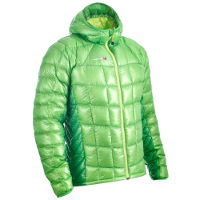
[/one_fourth]
[two_fourth]
There are so many down jackets on the market that it’s hard to pick out a single product. Just checking the Fill Power is an easy way to gauge the quality (500 is lower quality, 850 is top quality).
I’ve been using my Rab Neutrino Endurance jacket for 14 years everywhere from Siberia to the arctic to cold mornings in Yorkshire. It clocks in at 635g (22oz) of which 250g (9oz) is down. The down is good quality at 800 fill power and the Pertex shell is good for shedding snow.
>> Used by author for 14 years– >> Rating:![]()
![]()
![]()
![]()
![]()
[/two_fourth]
[one_fourth_last]
Want One?
[button color=”blue” link=”http://amzn.to/2gRgfAe” target=”_blank” size=”medium” fontw=”bold” align=”center” radius=”6″]Check Price >>[/button]
[/one_fourth_last]
[/box]
[divide]
Summary
–
[one_fourth]
Fleece
Fleece is cheap, robust and good in a range of situations but offers only limited insulation and is too bulky to rely on in cold conditions.
[button color=”blue” link=”http://amzn.to/2grUhk3″ target=”_blank” size=”small” fontw=”bold” align=”center” radius=”6″]Buy Fleece Midlayers ➜[/button]
[/one_fourth]
[one_fourth]
Pile Smocks
Bigger and heavier than synthetic jackets but much tougher and good temperature regulation so better for using on the go.
[button color=”blue” link=”http://amzn.to/2flIl1h” target=”_blank” size=”small” fontw=”bold” align=”center” radius=”6″]Buy Smocks ➜[/button]
[/one_fourth]
[one_fourth]
Synthetic Jackets
Insulated jackets are second only to down for warmth-to-weight but cheaper and not susceptible to water damage. Too sweaty to walk in though.
[button color=”blue” link=”http://amzn.to/2g0V5M4″ target=”_blank” size=”small” fontw=”bold” align=”center” radius=”6″]Buy Insulated Jackets ➜[/button]
[/one_fourth]
[one_fourth_last]
Down Jackets
Down jackets are expensive, fragile and can get ruined if wet but they offer better warmth for weight and size than anything else.
[button color=”blue” link=”http://tinyurl.com/hcenke3″ target=”_blank” size=”small” fontw=”bold” align=”center” radius=”6″]Buy Down Jackets ➜[/button]
[/one_fourth_last]
[divide]
Find that useful? You might like the other articles in my Comparison Series…
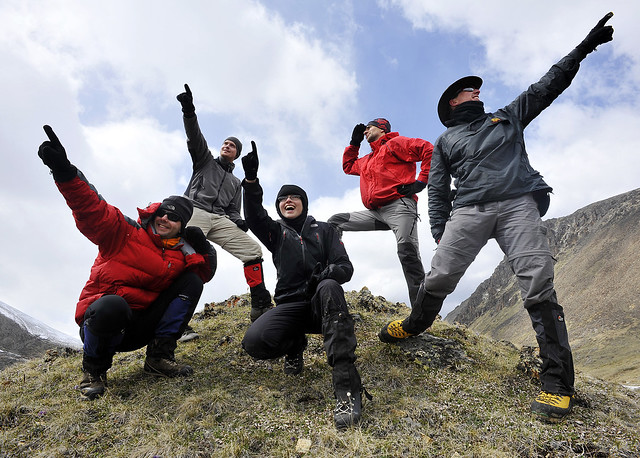
What do you think? Please do add your thoughts below…